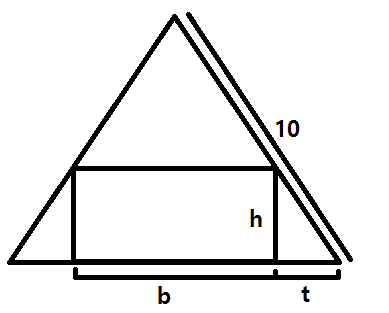A rectangle is inscribed in an equilateral triangle so that one side of the rectangle lies on the base of the triangle. How do I find the maximum area of the rectangle when the triangle has side length of 10?
1 Answer
Explanation:
First, let's look at a picture.

Some initial observations:
-
The area
AA of the rectangle isA=bhA=bh . -
By symmetry, the base of the triangle is of length
b+2tb+2t , and thus, as it is of length1010 , we haveb+2t = 10 => t = 5-b/2b+2t=10⇒t=5−b2 -
If we decide
bb that also determineshh , and thus we can writehh as a function ofbb .
To write
Solving for
Then, we can rewrite our formula for the area as
If we look at the graph for
And so the vertex, and thus the maximum area, is at
Finally, we calculate the area from this to get

